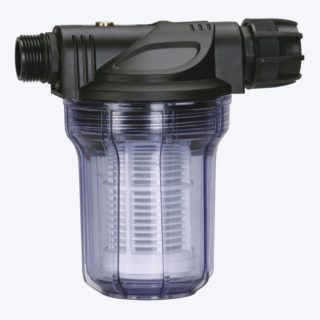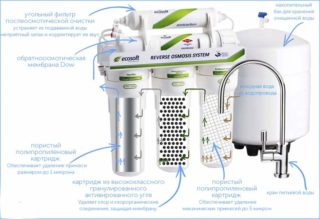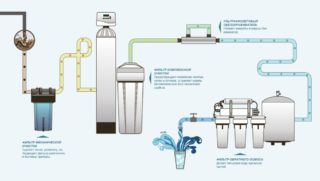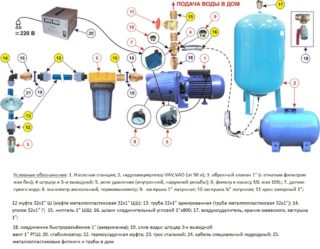For productive and non-stop operation of the pumping station, the installation of filtering devices is required. They will not allow contaminants to enter the device, which will cause wear and tear on the mechanical elements. In addition, filtration will make the water supplied from a well or well source suitable for drinking.
Types, device and purpose of filters for pumping stations

The content of silt and sand in the water negatively affects the pump itself and the hydraulic accumulator. The first has a reduced service life, the second is simply clogged and needs frequent cleaning. If a filtration device is installed, these problems can be avoided. The main thing is to choose the right cleaning equipment.
Mechanical filter devices
Filters of this type, used in conjunction with pumping units, can be coarse or fine. The first are of three types:
- Mesh inlet filters. Their cells vary in size - from 50 to 500 microns. The lower the indicator, the more the device will retain dirt impurities. Filtration elements can be washable or non-washable. The latter require systematic cleaning. The purification of the former occurs automatically. Sometimes they are equipped with a non-return valve, which prevents the outflow of liquid entering the pressure system. A variation of the design are also suction-type nets used for tank trucks, hand pumps and motor pumps.
- Cartridge devices. Tool, replaceable as it clogs, in a plastic case. Retains harmful impurities as small as 0.5 microns, including viscous elements such as mud and clay suspension. It is used for preliminary water purification.
- Pressure devices with air compressors. They operate at high speed and retain micro-contaminants as low as 30 microns. Filled with filter material, equipped with a regulator and a drainage compartment. The devices are large. Their installation is allowed only in warm rooms. If the site is extensive, it is better to choose such a water pre-filter for the pumping station, since it will not slow down the operation of the equipment.
Central coarse filters with mesh or filter discs inside are designed specifically for irrigation. Their installation is carried out by means of a tie-in into the water supply pipeline. The design makes it easy to remove the filter element as it gets dirty and put it back after cleaning.
Fine filtration devices are capable of retaining microparticles from 5 microns. They can be membrane, wire or synthetic fibers. The former are able to remove even the smallest impurities; the supplied water can be drunk raw.
Specialized cleaning equipment

In addition to mechanical devices, other types of filter elements are used:
- Ion exchange. The case of the apparatus made of metal or polymer is filled with ion-exchange resins necessary to soften water and retain heavy metal salts.
- Biological. Blocks with cleaning bacteria are installed inside the flasks, which destroy organic impurities.
- Electrical.Ozone in the filter element under the influence of electricity cleans the liquid from hydrogen sulfide, chlorides, iron ions, manganese and even from oily products.
- Physicochemical. The watercourse is purified as a result of the absorption of pollutants by an absorber - activated carbon. These should be installed where there are a lot of chloride compounds in the water.
Reverse osmosis filters are gaining popularity. Eco-friendly technologies allow you to get rid of all contaminants in the water. The devices are cylinders with a membrane cartridge. Passing through it under pressure, the liquid is separated into clean drinking water and a solution with a high content of impurities. Reverse motions are equipped with built-in automatic membrane cleaning systems.
For additional purification of water from iron impurities, special iron-retaining filters are used, which improve the taste, color and smell of water. They are installed directly in front of the kitchen, bathroom or shower.
Criterias of choice

To install suitable filters, it is necessary to know the capacity of the pumping station and the degree of water pollution: the size of impurities, the concentration of polluting chemical elements, microorganisms and bacteria. This can be found out after laboratory tests.
The first indicator is especially important if it is decided to install a reverse osmosis filter. The device requires a working head of 2.8 bar to operate. If the pumping unit is low-power, you will have to buy booster pressure equipment.
It is better if the coarse cleaning device is made of stainless steel. Galvanized parts have a much shorter service life, for plastic products it is even lower.
When selecting a mesh filtration device, the method of cleaning it is taken into account. A flow-through product requires a ball valve with a handle. When it is opened, part of the water flow will pass through the flask and flush it from all impurities.
The backwash device cleans itself after a certain period of time - from four minutes to three months. It is also possible to start the drive not by a timer, but remotely, or from a relay that responds to pressure drops. For such filters, it is necessary to install a stationary tank under them or connect to the sewer main.
If you do not want to buy separate filtering elements, you can purchase a modular unit, which includes: a pump, several filters for pre-cleaning and additional cleaning using post-filtering and mineralizing cartridges.
Equipment installation rules
There is a danger that the filter element will clog during operation, causing an increase in hydraulic resistance, which will increase the load on the pump, and the automation behind the filter will not feel this. To avoid damage to the equipment, the filter element must be regularly checked and cleaned. Or install an additional pressure switch that would shut off the pump in an emergency. An option would be to purchase a backwash device.
The correct connection of the water supply system is carried out according to the following arrangement of the constituent elements:
- Install a filter for coarse cleaning.
- Connect the pumping unit.
- Install fine filtration equipment;
- The assembled system is tested for leaks.
The installation of the filter element for coarse cleaning must be performed on a horizontal section of the water supply. In this case, you must choose a place where you can always conveniently and quickly get to the filter for inspection and maintenance.
When arranging pumping equipment, one should not save on the purchase of a filtering device. The absence of a filter leads to the ingress of dirt into the accumulator and to breakdown, which will require replacing an expensive part.









